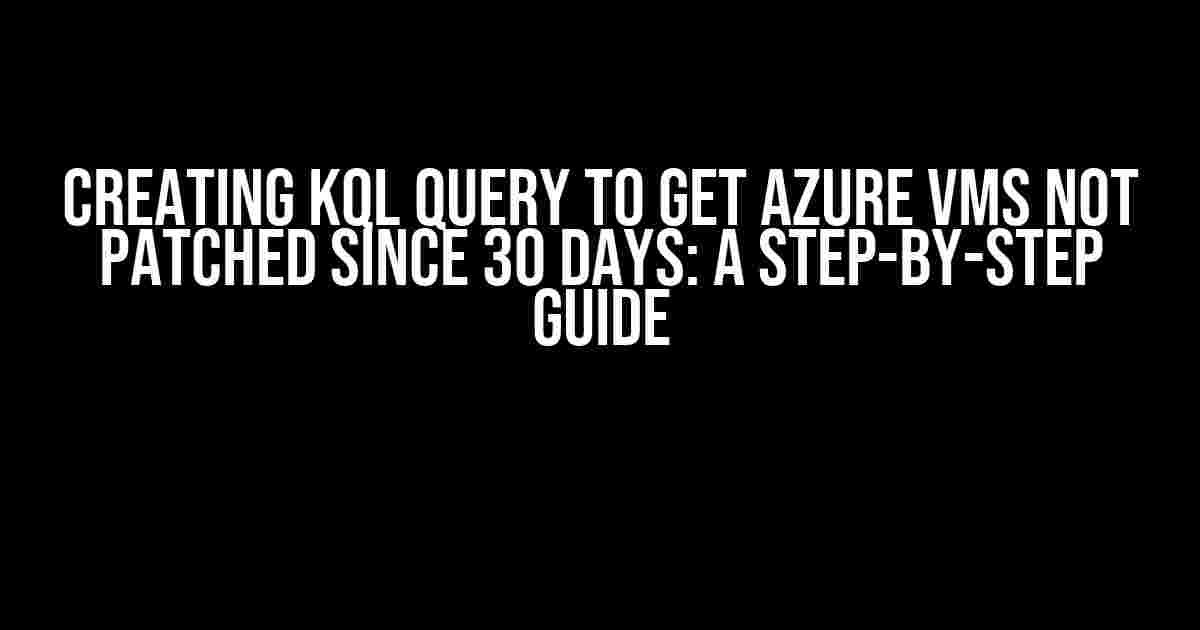Are you struggling to keep track of your Azure Virtual Machines (VMs) that haven’t received security patches in over 30 days? Worry not, friend! In this article, we’ll dive into the world of Kusto Query Language (KQL) and create a query that will help you identify those VMs that need some TLC.
What is KQL?
Kusto Query Language (KQL) is a powerful query language used to explore and analyze data in Azure Data Explorer, Azure Log Analytics, and Azure Monitor. It’s similar to SQL, but with a more concise and expressive syntax. KQL is designed to work with structured and semi-structured data, making it perfect for querying Azure resources.
Why Do I Need to Monitor Patched VMs?
Unpatched VMs are a security risk waiting to happen. Cyber threats and vulnerabilities can exploit these gaps, leading to data breaches, system compromise, and even ransomware attacks. By monitoring patched VMs, you can:
- Ensure compliance with security policies and regulations
- Reduce the attack surface of your Azure infrastructure
- Improve the overall security posture of your organization
Creating the KQL Query
Now, let’s get to the good stuff! To create the KQL query, we’ll need to follow these steps:
- Connect to your Azure Log Analytics workspace
- Use the
Updatetable to query update history - Filter results to show only Azure VMs
- Apply the 30-day threshold for patching
- Format the output for easy reading
let VMsNotPatched =
Update
| where classification == 'SecurityUpdate'
| where todatetime(lastupdatedatetime) < now(-30d)
| where computer in ((Resources
| where type == 'microsoft.compute/virtualmachines'
| project Computer = name))
| summarize
make_list(Computer),
make_list(name)
| project-away _
| sort by Computer asc;
VMsNotPatched
Breaking Down the Query
Let's dissect the query to understand what each part does:
Update: We're using theUpdatetable, which contains update history for all resources.classification == 'SecurityUpdate': We filter the results to show only security updates.todatetime(lastupdatedatetime) < now(-30d): We convert thelastupdatedatetimecolumn to a datetime format and compare it to the current time minus 30 days. This gives us the VMs that haven't received updates in over 30 days.computer in ((Resources ...)): We use a subquery to get a list of VMs from theResourcestable. We filter the results to show only Azure VMs (type == 'microsoft.compute/virtualmachines') and project thenamecolumn asComputer.summarize ...: We use thesummarizeoperator to group the results byComputerand create a list of affected VMs.project-away _: We remove the unnecessary columns from the output.sort by Computer asc: Finally, we sort the output in ascending order byComputername.
Running the Query
Now that we have our KQL query, let's run it in Azure Log Analytics:
1. Log in to your Azure Log Analytics workspace.
2. Click on the "Queries" button in the top left corner.
3. Click on the "New query" button.
4. Paste the KQL query into the query editor.
5. Click the "Run" button.
Understanding the Output
The query output will show you a list of Azure VMs that haven't received security patches in over 30 days, along with the number of updates required:
| Computer | Updates Required |
|---|---|
| vm-001 | 5 |
| vm-002 | 3 |
| vm-003 | 2 |
Next Steps
Now that you have a list of VMs that need patching, it's time to take action:
- Review the patching history for each VM to identify the missing updates.
- Apply the necessary patches using Azure Update Management or your preferred patching tool.
- Re-run the query to verify that the VMs have been updated successfully.
By following these steps, you'll be able to identify and address potential security risks in your Azure environment, ensuring the security and compliance of your infrastructure.
Conclusion
Creating a KQL query to get Azure VMs not patched since 30 days is a straightforward process that can help you maintain a secure and compliant Azure environment. By following this guide, you'll be able to identify and address potential security risks, reducing the attack surface of your infrastructure.
Remember to regularly review and update your query to ensure it remains effective in identifying unpatched VMs. Happy querying!
Frequently Asked Question
Getting stuck while creating a KQL query to get Azure VMs not patched since 30 days? Worry not, we've got you covered!
What is the purpose of creating a KQL query to get Azure VMs not patched since 30 days?
The purpose is to identify and report on Azure Virtual Machines (VMs) that have not been patched with the latest security updates for at least 30 days, enabling IT teams to take proactive measures to mitigate potential security risks.
What is the basic structure of a KQL query to achieve this?
The basic structure of a KQL query to get Azure VMs not patched since 30 days would be: `let patchThreshold = 30d; VM | where LastPatchDate < ago(patchThreshold)`. This query uses the `let` statement to define a patch threshold of 30 days, and then filters VMs based on their `LastPatchDate` being older than the threshold.
How do I modify the query to include specific VM types or platforms?
You can modify the query to include specific VM types or platforms by adding additional filters. For example, to include only Windows VMs, you can add `| whereOSType == 'Windows'`. To include only specific VM types, such as Standard_D2s_v3, you can add `| whereVMSize == 'Standard_D2s_v3'`. You can combine multiple filters using logical operators like `and` and `or`.
Can I use KQL to get the patch history of a specific Azure VM?
Yes, you can use KQL to get the patch history of a specific Azure VM. You can use the `VM_SecurityUpdate` table and filter by the `VMId` or `Computer` column to get the patch history for a specific VM. For example: `VM_SecurityUpdate | where Computer == 'myvm123' | project Computer, UpdateState, UpdateDateTime, KBID`. This query retrieves the patch history for a VM named 'myvm123', including the update state, date, and KB ID.
Are there any best practices to optimize my KQL query performance?
Yes, there are several best practices to optimize KQL query performance. These include using efficient data types, avoiding expensive operations, using indexes, and optimizing filter orders. Additionally, consider using the `take` operator to limit the number of results, and use the `materialize` function to materialize intermediate results. You can also use Azure Log Analytics query optimization tools to identify performance bottlenecks and optimize your queries.
Now, go ahead and craft your KQL query to get Azure VMs not patched since 30 days with confidence!


